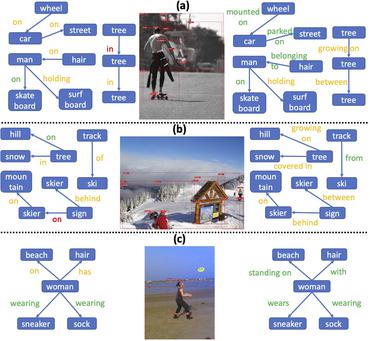Scene Graph Generation
110 papers with code • 5 benchmarks • 7 datasets
A scene graph is a structured representation of an image, where nodes in a scene graph correspond to object bounding boxes with their object categories, and edges correspond to their pairwise relationships between objects. The task of Scene Graph Generation is to generate a visually-grounded scene graph that most accurately correlates with an image.
Libraries
Use these libraries to find Scene Graph Generation models and implementationsMost implemented papers
Mapping Images to Scene Graphs with Permutation-Invariant Structured Prediction
Machine understanding of complex images is a key goal of artificial intelligence.
Factorizable Net: An Efficient Subgraph-based Framework for Scene Graph Generation
Generating scene graph to describe all the relations inside an image gains increasing interests these years.
The Limited Multi-Label Projection Layer
We propose the Limited Multi-Label (LML) projection layer as a new primitive operation for end-to-end learning systems.
Bridging Knowledge Graphs to Generate Scene Graphs
Scene graphs are powerful representations that parse images into their abstract semantic elements, i. e., objects and their interactions, which facilitates visual comprehension and explainable reasoning.
Weakly Supervised Visual Semantic Parsing
Scene Graph Generation (SGG) aims to extract entities, predicates and their semantic structure from images, enabling deep understanding of visual content, with many applications such as visual reasoning and image retrieval.
NODIS: Neural Ordinary Differential Scene Understanding
Detected objects, their labels and the discovered relations can be used to construct a scene graph which provides an abstract semantic interpretation of an image.
GPS-Net: Graph Property Sensing Network for Scene Graph Generation
There are three key properties of scene graph that have been underexplored in recent works: namely, the edge direction information, the difference in priority between nodes, and the long-tailed distribution of relationships.
Graph Density-Aware Losses for Novel Compositions in Scene Graph Generation
We show that such models can suffer the most in their ability to generalize to rare compositions, evaluating two different models on the Visual Genome dataset and its more recent, improved version, GQA.
Generative Compositional Augmentations for Scene Graph Prediction
However, test images might contain zero- and few-shot compositions of objects and relationships, e. g. <cup, on, surfboard>.
Sketching Image Gist: Human-Mimetic Hierarchical Scene Graph Generation
Scene graph aims to faithfully reveal humans' perception of image content.





 MS COCO
MS COCO
 Visual Genome
Visual Genome
 VRD
VRD
 3DSSG
3DSSG
 3RScan
3RScan
 PSG Dataset
PSG Dataset
 4D-OR
4D-OR


